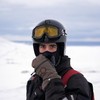Longyearbyen, the largest down in Svalbard.
Polar bears outnumber humans in this part of the world.
The author tucking into a stick of reindeer meat.
Author's shopping: reindeer sticks, freeze-dried reindeer soup and smoked whale.
The author enjoying some smoked whale.
The author talks to Iris, owner of Mary Anne's Polarigg.
Antipasti Svalbard style: whale meat, seal meat, reindeer meat.
A Svalbard reindeer grazes peacefully just outside the town. Local reindeer are characterised by particularly short legs.
Frederik, head chef at Huset Svalbard.
Smoked reindeer on a mushroom mousse.
Reindeer carpaccio wrapped in a reindeer roll-up with dried seaweed and salmon caviar.
